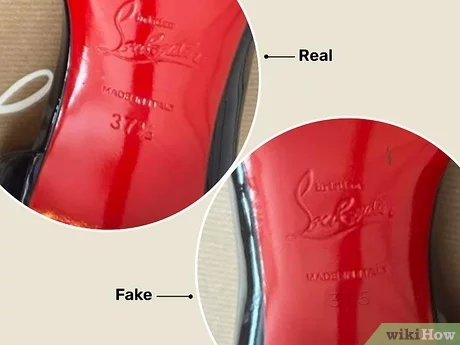Christian Louboutin shoes are a hallmark of luxury and elegance, recognized by their iconic red soles. However, their high price tags make them a coveted item in the secondhand market. If you’re considering investing in vintage Christian Louboutin shoes, it’s crucial to know how to distinguish authentic pairs from fakes and ensure they’re in good condition.
This guide will help you make an informed decision when buying secondhand Christian Louboutin shoes. Taking the time to thoroughly inspect your potential purchase can save you from costly mistakes and ensure you get the quality you deserve.
1. Verify the Red Sole
The signature red sole is perhaps the most iconic feature of Christian Louboutin shoes, making it a primary indicator of authenticity.
Authentic Louboutin soles are a specific shade of vibrant red, almost like a lacquer finish. This unique red is both striking and consistent. Counterfeit shoes often fail to replicate this exact color, using shades that are too dull, too bright, or even matte. Examine the sole closely in natural light to verify its hue and finish. A genuine sole also maintains its shine longer, even with regular use, compared to the dull look of counterfeits.
Additionally, the material and texture of the sole should feel premium. Authentic Louboutin soles are made of leather or high-quality materials, whereas fake ones may feel plastic-like or overly stiff. Look for wear patterns—genuine secondhand pairs will show signs of use but should still retain their distinct red sole. Minor scuffs are normal in pre-owned pairs, but excessive damage may indicate poor quality or counterfeit origins.
2. Inspect the Logo and Branding
Every pair of Christian Louboutins features meticulous branding that is hard to replicate.
Start with the insole. Authentic Christian Louboutin shoes have the brand’s name printed in a clear, crisp font. The text should read “Christian Louboutin Paris” and appear evenly spaced. Counterfeit pairs often have uneven fonts, misspellings, or misaligned text. Feel the print—authentic logos are embossed and not merely printed. This embossing ensures durability and adds a tactile quality to the branding that fakes often lack.
On the sole, look for the “Christian Louboutin” stamp, which includes the size and “Made in Italy”. The font and placement should match authentic models. Any errors in spelling, inconsistent font size, or poor-quality engraving are red flags. Furthermore, authentic pairs often have a unique coding system on the inside of the shoe or packaging, which counterfeiters typically overlook.
3. Examine the Quality of Materials
The craftsmanship of Christian Louboutin shoes is unparalleled, and this is a key way to spot fakes.
Authentic Louboutins are made of premium materials, whether it’s leather, suede, or exotic skins. Check for uniform stitching and flawless edges—there should be no loose threads or rough cuts. The lining should also feel luxurious, often made of smooth leather. Counterfeit shoes typically use cheaper materials, resulting in uneven stitching, synthetic textures, and a less polished finish. Genuine Louboutin shoes also have soles that are securely attached, unlike counterfeits where glue marks or uneven edges might be visible.
If you’re purchasing cheap pre-owned Christian Louboutin shoes, assess how well the materials have aged. Genuine pairs will wear gracefully, with minimal cracking or peeling, even when used. Cheap imitations, on the other hand, deteriorate quickly and show visible flaws. Take the time to closely examine both the interior and exterior materials, as any signs of poor craftsmanship can indicate a fake.
4. Research the Style and Serial Number
Each Christian Louboutin design is unique and comes with specific identifiers.
Start by identifying the model you’re interested in and compare it with official photos from the brand’s website or authorized retailers. Pay attention to details like the heel height, shape, and embellishments. Counterfeit manufacturers often get these details wrong, producing shoes that deviate from the authentic design. For example, authentic embellishments will have precise placement and symmetry, while fakes often appear uneven or poorly attached.
For newer styles, check for a serial number or QR code on the shoebox or inside the shoe. This number can often be verified through the official Christian Louboutin website or by contacting their customer service. If the secondhand seller cannot provide these details, proceed with caution. Additionally, some vintage models may not have serial numbers, so research the production period to understand what identifiers to look for.
5. Evaluate the Seller’s Reputation
The source of your secondhand Christian Louboutin shoes can greatly influence their authenticity.
Buy from reputable platforms that specialize in luxury resale, such as The RealReal, Vestiaire Collective, or StockX. These platforms authenticate products before listing them for sale. If you’re buying directly from an individual, request proof of purchase or original packaging to verify their claims. This added documentation not only confirms authenticity but can also give you a sense of the shoe’s history and maintenance.
Make Your Investment Worthwhile
Buying secondhand Christian Louboutin shoes is a smart way to own a luxury item at a fraction of the cost. However, ensuring authenticity and quality is essential to making your purchase worthwhile. By focusing on the red sole, branding, materials, style identifiers, and seller reputation, you can confidently spot authentic and well-maintained pairs. Always take the time to research thoroughly and avoid rushing into a deal, as this will enhance your overall shopping experience.
You may also read: 5 Ways a Skilled Yoga Teacher Can Elevate Your Practice
When you’re ready to invest, keep in mind that vintage Christian Louboutin shoes may still require proper care and occasional restoration to preserve their elegance. Treat your pair with care, and they’ll serve as a timeless addition to your wardrobe. Proper storage, cleaning, and occasional professional maintenance can also extend their life and maintain their value over time.

